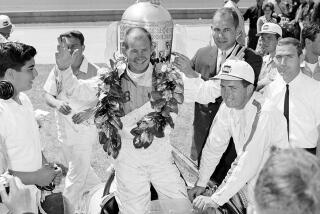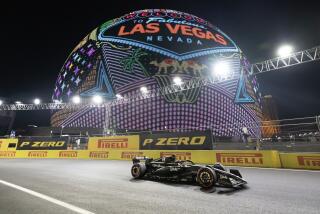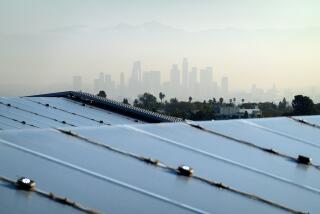Soft Walls Are a Big Hit
- Share via
INDIANAPOLIS — The new “soft walls” installed in the four turns of Indianapolis Motor Speedway are definitely not soft, say the drivers who unfortunately served as guinea pigs, but they have lived up their acronym: SAFER.
The SAFER (Steel and Foam Energy Reduction) barriers were put in place May 5 for the first day of practice for the Indianapolis 500 and were tested immediately.
Robby McGehee spun, hit the wall twice and nearly flipped his car on opening day, the car sustaining serious damage. Two days later, rookie PJ Jones slammed into the wall, rear-end first, with such impact that the front end of his car lifted nearly four feet in the air.
Mark Dismore, Alex Barron and Paul Tracy also had extremely hard hits.
All of the drivers walked away, though, hurting but not seriously injured. None had head injuries, one of the major concerns in such accidents.
“I’m not pleased about it, but I am a walking testament that the SAFER wall worked,” said McGehee, the 1999 rookie of the year who returned to the speedway on crutches after suffering small fractures in his upper spine and lower left leg. “I’m sore as hell, but the fact that I hit the wall that hard and I don’t have a head injury is a testament that the SAFER wall worked. I think I would have a head injury, for sure, without it.”
McGehee was traveling at close to 220 mph when his car broke loose entering the third turn and spun backward into the newly installed barrier.
Brian Barnhart, Indy Racing League vice president, said McGehee’s first hit had a force of 40 Gs, the second a force of 72 Gs.
“Both numbers are far less than had been recorded in similar accidents before the SAFER barrier was put in place,” he said.
The idea of the barriers, which cover 4,240 feet of Indianapolis Motor Speedway’s permanent outside wall around the 2.5-mile track, is to absorb energy before it impacts the driver.
“The goal was to reduce the forces seen on the car to a range that lessens the likelihood of the driver being injured,” Barnhart said. Jones, finally getting a chance at the 500 after years at other series, vouched for that.
“Obviously, the new walls really helped my impact and I probably wouldn’t be in nearly as good of shape as I am right now without them,” said PJ, son of 1963 winner Parnelli Jones. “The speedway really did something positive, putting that system in place. For all I went through, I’m not in any pain and I don’t actually feel hurt, but I have some cracks in a vertebra that are going to take a short time to heal.
“It’s such a shame. I can’t really believe it. It’s my first 500 and we were running so well. I felt like we had a car to win the race.”
He might be right. Raul Boesel replaced Jones in John Menard’s backup No. 2 car and, with only two days of practice, put it on the front row for Sunday’s 500.
Richie Hearn took over Dismore’s repaired car and put it in the field the first weekend of qualifying, then last weekend, Barron and Tracy, in repaired cars, and Dismore, in another car, all qualified for spots in the 33-car starting field.
The new energy-absorbing barrier was developed jointly by the IRL and the University of Nebraska’s Midwest Roadside Safety Facility. They began working together in 1998. NASCAR joined in the development in 2000, after the barrier was designed for multiple impacts by 3,400-pound Winston Cup stock cars as well as 1,550-pound IRL open-wheel cars.
“NASCAR has not said it will use the barriers for the Brickyard 400 [at the speedway in August], but is taking a wait-and-see attitude,” said Fred Nation, IRL director of communications. “They have participated in its development and seen our tests, but so far, that’s all.”
Winston Cup driver Johnny Benson, who is also part owner of Berlin Speedway in Marne, Mich., applauded the installation of the barriers.
“It’s great that Indianapolis has taken us to the next step in safety,” he said. “As a driver, I’m glad NASCAR is right there supporting them. This will help driver safety now and even more so in the future as more tracks use this technology.
“I’ve been lucky and never hit the wall at Indy, but it’s a great place for this technology to be introduced. It’s a high-profile racetrack and hopefully it will influence other tracks to do the same thing with the new wall system.”
Crash tests were done with stock cars as well as IRL cars, the test cars being towed on a pulley at speeds between 100 and 153 mph and at angles of 20 to 251/2 degrees.
McGehee and Jones hit the wall going about 220 at angles of almost 90 degrees.
Said John Rhode, associate professor of engineering at Nebraska, “Looking at PJ’s hit, it was kind of miraculous, really. He had an impact change of 100 feet per second but it occurred over 120 milliseconds, which is a long time for that type of impact. It was a hit that had a tremendous amount of energy that was dissipated with moderate loads on the vehicle. We know we have to get the decelerations diminished and that’s what we’re doing here.”
The barrier is constructed in 20-foot modules, each module consisting of four rectangular steel tubes welded together to form a unified element. The modules are connected with four steel splices. Bundles of two-inch-thick sheets of yielding polystyrene are placed between the concrete wall and the steel tubing modules every 10 feet. Six or seven sheets of polystyrene are used in each bundle, depending on the location of the module in the turn.
“One of the prerequisites presented to us was to create a barrier robust enough to absorb an incredible impact and yet maintain its integrity so the event could continue with little or no delay for repair,” said Dean Sickling, director of the Nebraska facility.
“The principle behind the wall is, it provides a continuous barrier system that will remain parallel to the track and move back as a unit as it dissipates energy. The need for that movement is to prevent pocketing, which is where the barrier wraps around the front of the car, which extremely increases deceleration.”
Several years ago, the speedway installed an earlier version of the barrier, but when Arie Luyendyk crashed into it during an International Race of Champions it bounced his car back onto the center of the track and scattered debris for 100 yards.
Luyendyk suffered a slight concussion, but he credited the barrier with saving him from a more serious injury. However, the rebound effect and the delay in cleaning up after the accident sent IRL officials back to the drawing board.
The impacts this month caused hardly any damage to the polystyrene sheets and other parts of the system.
The barrier is painted white to match the speedway’s traditional wall color and is unobtrusive, even to the drivers.
Jeff Ward, second-place finisher in the 1999 Indy 500, took a ride around the track in a pace car before practice one day to inspect the new barrier.
“After that, I never noticed it again,” he said. “It’s white and it blends right in.”
The SAFER walls are a continuation of the safety innovations and improvements put in place by the IRL since 1998.
That year, the technical staff, with Delphi Automotive Systems, developed a yellow-light warning system that blinks in car cockpits when a caution is called on the track. That same year, attenuators were added to the backs of the Indy car transmissions to lessen G-forces in rear impact crashes.
Acting to prevent wheels from flying off the car in high-speed accidents, a danger to both drivers and spectators, the IRL mandated the use of multiple restraints attached at multiple points to a car’s chassis and suspension to minimize the possibility of wheel assembles being detached.
In 2000, chassis manufacturers were required to design all-new chassis with safety-inspired changes. Among them were increasing the width of the cockpit opening to 19 inches, providing better head protection through increased headrest thickness, adding additional anti-intrusion barriers on the chassis sides to improve side-impact performance, increasing the outer edges of side pods to reduce the possibility of interlocking wheels, and introducing collapsible steering wheels.
This year, besides adding the SAFER barriers, the IRL has mandated helmets for all over-the-wall personnel during races.
“Safety in our sport in every area, whether it is the wall or any other aspect of the car, is an ongoing development,” Barnhart said. “I think that is going to be the case with the wall, as well.”
More to Read
Go beyond the scoreboard
Get the latest on L.A.'s teams in the daily Sports Report newsletter.
You may occasionally receive promotional content from the Los Angeles Times.










